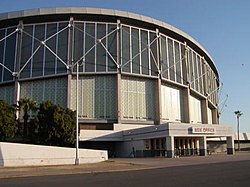Arizona Veterans Memorial Coliseum
| The Coliseum | |
 |
|
| Location | 1826 West McDowell Road, Phoenix, Arizona 85007 |
|---|---|
| Coordinates | 33°28′10″N 112°5′48″W / 33.46944°N 112.09667°WCoordinates: 33°28′10″N 112°5′48″W / 33.46944°N 112.09667°W |
| Owner | Arizona Exposition and State Fair Board |
| Operator | Arizona Exposition and State Fair Board |
| Capacity |
Basketball: 14,870 Ice hockey: 13,730 |
| Construction | |
| Broke ground | August 11, 1964 |
| Opened | November 3, 1965 |
| Construction cost | US$7 million ($53.2 million in 2017 dollars) |
| Architect |
Lescher & Mahoney Place & Place |
| Structural engineer | T. Y. Lin International |
| General contractor | Manhattan–Dickman |
| Tenants | |
|
Phoenix Roadrunners (WHL) (1967–74) Phoenix Suns (NBA) (1968–92) Phoenix Roadrunners (WHA) (1974–77) Phoenix Racquets (WTT) (1975–78) Phoenix Roadrunners (CHL) (1977) Phoenix Roadrunners (PHL) (1977–79) Phoenix Inferno (MISL) (1980–84) Phoenix Roadrunners (IHL) (1989–97) Phoenix Mustangs (WCHL) (1997–2001) Phoenix Eclipse (ABA) (2001–02) Arizona Thunder (WISL) (1998–2000) Phoenix Flame (IBL) (2007) Arizona Derby Dames (roller derby) (2009–present) |
|
Arizona Veterans Memorial Coliseum is a 14,870-seat multi-purpose indoor arena in Phoenix, Arizona, located at the Arizona State Fairgrounds. It hosted the Phoenix Suns of the National Basketball Association from 1968 to 1992, as well as indoor soccer, roller derby and professional and minor league ice hockey teams.
Newspaper reports state that The Arizona State Fair Commission began planning for an "Arizona State Fairgrounds Exposition Center" as early as the fall of 1962. The Commission envisioned an indoor facility which could be used during the State Fair as well as year-round. In 1964, Phoenix architect Leslie Mahoney, of the Lescher and Mahoney firm (designers of the Orpheum Theatre in downtown Phoenix among others) presented the commission with the final plans, and construction began that summer. Tucson architect Lew Place (son of University of Arizona chief campus architect Roy Place, and who later took over his father's firm) was also involved in the design. The structural engineering firm was T. Y. Lin International.
The unique saddle-shaped, tension-cable roof, supporting over 1,000 precast concrete panels, was considered innovative architectural engineering at the time. It may have been at least partially influenced by the equally innovative Dorton Arena at the North Carolina State Fair in Raleigh, completed in 1952. Veterans Memorial Coliseum also contains a series of murals by Phoenix artist Paul Coze. The design influenced later arenas' architecture, including the Capital Centre in Landover, Maryland and the Scotiabank Saddledome in Calgary, Alberta.
...
Wikipedia
